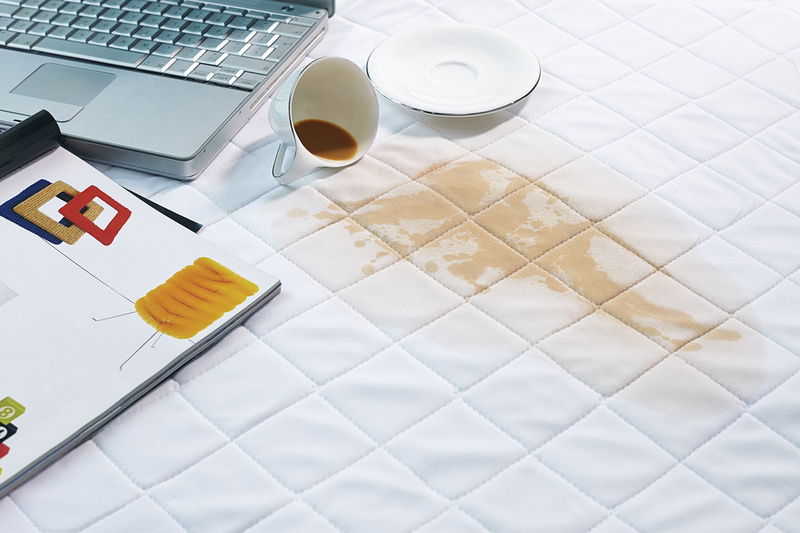DIY Solutions for a Mould-Free Window Sill Experience
Posted on 17/06/2025
DIY Solutions for a Mould-Free Window Sill Experience
Are you tired of seeing unsightly black spots and smelling that musty odor around your window sills? You're not alone. Mould around window sills is a common household problem, but thankfully, it can often be tackled with simple DIY solutions. This comprehensive guide will walk you through effective methods for a mould-free window sill experience, ensuring both immediate removal and long-term prevention. Keep reading for tips, step-by-step instructions, and expert advice to keep your home fresh and healthy!

Why Does Mould Grow on Window Sills?
Before launching into DIY solutions for mould-free window sills, it's crucial to understand why mould appears in the first place. Mould thrives in moist, warm, and poorly ventilated areas--and window sills often check all these boxes. When condensation forms on windows due to temperature differences between indoors and outdoors, moisture accumulates on the sills, creating the perfect environment for mould spores to settle and multiply.
- Improper sealing allowing water seepage
- Lack of sunlight exposure
- Inadequate ventilation in the room
- Outside weather conditions
- Frequent indoor plant watering near windows
Mould isn't only a cosmetic issue. It can damage your windows' structural integrity and trigger allergies or other respiratory health problems. Tackling the problem early is key!
Assessing the Extent of Mould on Your Window Sill
The first step towards a healthy, mould-resistant window sill is an honest assessment. Regularly inspect your window sills, frames, and surrounding walls, especially during wetter months. Look for:
- Black, green, or white patches: Discoloration is a major sign of mould.
- Musty smells: Even if you don't see mould, if the area smells musty, it's likely present.
- Peeling paint or wallpaper: Hidden mould often lurks behind.
- Condensation and water droplets: Persistent moisture signals high mould risk.
Before You Start: Safety Precautions
- Wear gloves, goggles, and a face mask: Even small quantities of mould release spores that can be irritating.
- Open windows and doors: Ensure proper ventilation while cleaning.
- Test on a small area first: If you're using any liquid solution, check to avoid damage to paint or wood.
DIY Cleaning Solutions to Remove Mould from Your Window Sill
There are several options for removing mould from window sills naturally. The best solution for you depends on the severity of the infestation and available products.
1. White Vinegar Solution
White vinegar is a natural and effective mould remover thanks to its mild acidity, which kills most mould spores.
- Pour undiluted white vinegar into a spray bottle.
- Spray directly onto the mould-affected area.
- Allow it to sit for at least one hour.
- Scrub with a soft brush or microfiber cloth.
- Wipe the area with a clean, damp cloth and dry thoroughly.
2. Baking Soda and Water Paste
*Baking soda* is gentle on surfaces and absorbs odors.
- Mix 1/4 tablespoon baking soda with a few drops of water to make a paste.
- Spread it across the mouldy spots and let rest for 10-15 minutes.
- Scrub gently with a soft-bristled brush.
- Rinse with water and dry the area completely.
3. Hydrogen Peroxide Method
For tougher or more stubborn patches, *hydrogen peroxide* (3%) can be very effective.
- Pour hydrogen peroxide into a spray bottle.
- Generously spray onto the mouldy surface.
- Allow it to bubble for 10-15 minutes.
- Scrub and wipe clean, ensuring no peroxide residue remains.
4. Tea Tree Oil Solution
*Tea tree oil* contains strong antifungal properties.
- Mix one teaspoon of tea tree oil with one cup water in a spray bottle.
- Shake well and spray directly onto mouldy areas.
- Let stand for an hour, then scrub and wipe clean.
Pro tip: Never mix cleaning agents like bleach and vinegar; dangerous gases may be produced.
Preventing Mould Growth on Window Sills
Getting rid of mould only solves half the battle. To ensure a lasting mould-free window sill experience, it's essential to focus on *prevention* as well:
1. Control Humidity and Ventilation
- Keep indoor humidity below 60% (ideally 30-50%). Use a dehumidifier if needed.
- Open windows regularly to promote air circulation.
- Use exhaust fans in bathrooms and kitchens.
2. Regular Cleaning and Inspection
- Dust and wipe down window sills weekly.
- Check for condensation, especially after storms or cold nights.
- Inspect seals and caulking for cracks or gaps; repair as soon as possible.
3. Improve Natural Sunlight Exposure
- Open curtains during the day to let sunlight reach the sills; UV rays are natural mould-killers.
- Consider trimming outdoor foliage that blocks windows.
4. Seal and Protect Window Frames
- Apply waterproof caulk to seal gaps and prevent moisture entry.
- Paint wooden sills with mould-resistant paint or varnish.
- Fix or replace damaged window panes or weatherstripping.
Eco-Friendly Tips for a Mould-Free Window Sill Life
If you're conscious about chemicals, many sustainable options exist for a healthier home and planet. Here are some *green* and natural approaches for maintaining cleanliness as part of your DIY mould-free window sill project:
- Lemon juice and salt: Naturally acidic and abrasive for mild infestations.
- Clove oil: Mix a few drops in water and leave on surfaces to kill spores.
- Regular airing: Fresh, dry air is mould's enemy.
Never underestimate the power of old-fashioned elbow grease combined with daily fresher air!
What Not to Do: Common Mistakes to Avoid in Window Sill Mould Removal
- Don't use dry wiping or vacuuming: This may release mould spores into your indoor air.
- Never cover mould with paint or wallpaper: This traps the spores and worsens the issue over time.
- Don't delay repairs on leaks or broken seals: Water intrusion is the primary cause of recurring mould.
- Avoid excessive water during cleaning: Use only damp cloths to prevent more moisture soaking into the window wood or plaster.
Long-Term Strategies for a Lifetime of Mould-Free Window Sills
1. Upgrade to Double or Triple-Glazed Windows
Advanced windows reduce condensation by keeping the inner glass warmer and preventing moisture from collecting on the sills.
2. Install Insulated Curtains or Blinds
While letting in sun during daytime is great, insulated options at night can further reduce condensation by regulating indoor temperature.
3. Move Houseplants Away from Window Sills
Excess watering near windows can boost moisture and encourage mould growth. Place plants on waterproof trays and position them away from direct contact with sills.
4. Monitor Home Humidity
- Invest in a digital hygrometer to easily track indoor humidity.
- Certain houseplants like Boston ferns and peace lilies actually reduce household humidity by absorbing it.

When to Call a Professional for Mould Removal
While these DIY solutions for mould-free window sills work well for minor to moderate problems, some situations require expert intervention. Look for:
- Severe, recurring mould infestations despite cleaning.
- Signs of structural damage (rotted wood, severe staining, or warping).
- Mould patches larger than one square metre.
- Mould spreading behind walls or into insulation.
- Family members experiencing unexplained respiratory symptoms.
A professional inspection can identify hidden sources, repair water damage, and completely remediate the problem, ensuring a lasting *mould-free window sill lifestyle*.
Conclusion: A Healthier Window Sill and Healthier Home
With some vigilance and the right DIY mould removal tips, maintaining a spotless, odour-free, and healthy window sill is very achievable. Whether you're eliminating an existing infestation or fortifying your home against future outbreaks, these *simple steps and sustainable solutions* will transform your window areas and protect your home for years to come.
For maximum effectiveness, focus on clearing existing mould, fixing water problems, improving airflow, and adopting a regular cleaning schedule. Not only will you enjoy attractive, long-lasting sills, but you'll also safeguard your family's health.
- Inspect regularly and act early
- Control moisture and humidity in your home
- Use natural, safe cleaning solutions
- Maintain seals and caulking on all windows
With these steps, your DIY solutions for a mould-free window sill experience will deliver results that last, leaving you with peace of mind and a fresher, safer, and more beautiful home environment.
Looking for more DIY tips? Browse our other guides for a complete toolkit for a healthier home!
```


